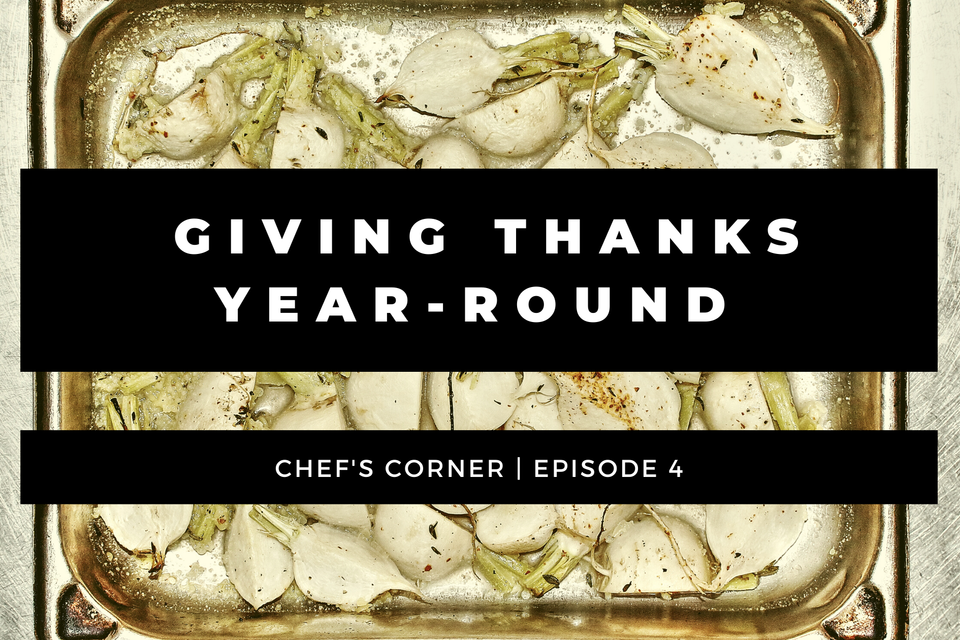Giving thanks year-round | Chef's Corner | Episode 4
By Hari Pulapaka, PhD, WCMC, CEC
November 22, 2021 The Wampanoag (People of the First Light) were likely expressing their gratitude and thanks for harvests and other bounties long before 1621. Through the centuries, the 67 or so villages that comprised the Wampanoag Nation in the 1600s on “Turtle Island” have seen their population in the region dwindle by as much as 80 percent. Brined, roasted, smoked, deep-fried, spatchcocked, sautéed, glazed, braised, pressure-cooked, sous-vide, reverse-seared, roulade, terrine, pate — all are culinary techniques taught in a first course for professional cooks in most reputable culinary schools. Many Americans swear by their technique(s), offer sage (pun intended) advice to lesser cooks, and analyze their outcomes for days after the fourth Thursday of every November. Some cooks begin prepping and cooking at least one day ahead (mise en place). Some make a mess doing so, while others clean as they go.
The ability to work efficiently, stay organized, clean along, and have at least a loose plan — even as one may be “salt baeing” (so annoying and disrespectful) one’s dishes — demonstrate command and confidence as a cook. To this day, before any cooking event, I organize my shopping list and order of preparation. Unlike some chefs, execution for me is instinctive and in the moment. Just like when dishes and bowls start disappearing into the dish pit (avoid the sink) during a multi-course dinner, the removal of items from the list indicates progress toward completion. Also, when tasting spoons start disappearing, it’s a sure sign that the food is being tasted in stages, as it should. Clean as you go and avoid cluttering your space with unwanted items. For example, don’t put a stockpot on the stove if you aren’t actually making a stock. The extra burner can help you in the moment for something else. Finally, use your oven to finish cooking dishes (it’s what we do in the restaurant), because it frees up the stovetop for more cooking.
I'm thankful for my wife Jenneffer, my 90-year-old mother Padmavathy Rao Pulapaka, mother-in-law Nancy Clark, for other family near and far, and dear friends. Being a chef and educator continually presents me with opportunities to make a difference in myself and the world, and for that, I am thankful. About a year ago, I became a naturalized citizen of the United States of America. I am thankful for that. After being fully vaccinated, I caught the virus not long after returning to full-time, in-person teaching. I am thankful that I didn’t need to be hospitalized.
For six months now, we have been rehabilitating Ranee, the backyard “feral” mother of Chotee, Jeffrey, and so many others who have found loving homes. Without even trying, she proves each day that humans can be such babies. I am thankful for the time we have with her. We had to bid farewell to the inimitable, greater-than-life Mr. John Edward Clark on Nov. 10. I am thankful for knowing him, the memories we made, and the kindness and love with which he accepted me as his own son. After two-and-a-half years, finally, I am scheduled to visit my mother, brothers, sisters-in-law, niece, and nephews. With bated breath, I am thankful.
Thanksgiving Week is America’s food holiday, even as millions of Americans experience food insecurity year-round. Thanksgiving signals the beginning of the holidays, as retailers and small businesses hit their peak-season stride. Amidst all the purchasing, corporate, and individual philanthropy peaks during the holidays. Can you imagine a world where empathy, kindness, and giving thanks happens year-round? We should (imagine).
Local Ingredient of the Week
TURNIPS
Turnips are a relatively quick-growing, cool-weather crop. In Florida, turnips may be planted as early as August and with a 40-60 day maturation period, they can be harvested for the Thanksgiving Table. The greens may be cooked into a soup or simply sautéed with olive oil, garlic, red pepper flakes, and fresh lemon. The roots can give an elevated alternative to potato in vichyssoise or roasted and baked for a comforting rendition. Equal to radishes, turnips offer flavor, versatility, and nutrition to any meal.





